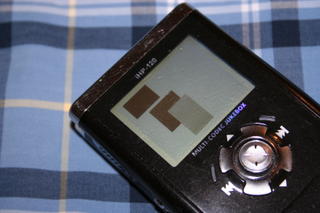Interactivity!
After I got text output working, I wrote a ultoa and itoa routine and some code to output conversions of all ADC channels. From this, I can read values that will help me interprit the various button presses. I noticed that the play and hold buttons on both the remote and main player didn't result in an ADC change, but found GPIOs that corresponded to them. So I think I will try to write a pong game soon as a demo, but I will probably need to get timing working first. Well anyways, here's an image of my tool, with descriptions of the different readouts (click image to see bigger):

I found a site that hosts files like these, so if anyones interested you can download it here (compatible with the rockbox bootloader). I hope to setup a sourceforge page shortly.

I found a site that hosts files like these, so if anyones interested you can download it here (compatible with the rockbox bootloader). I hope to setup a sourceforge page shortly.



